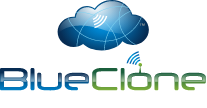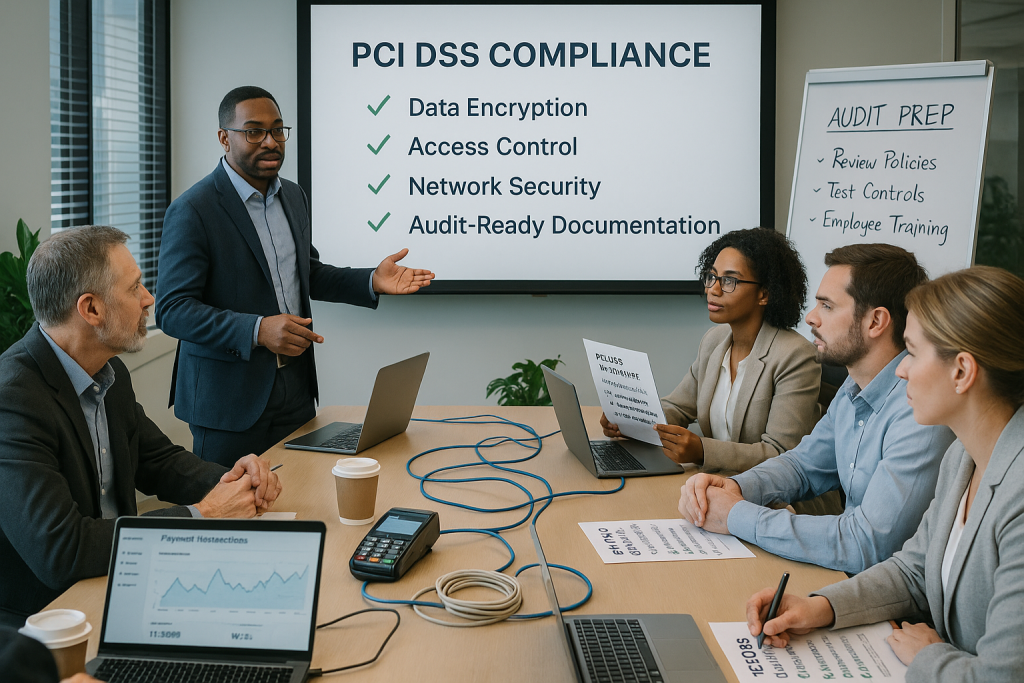Understanding PCI DSS Compliance: Why It’s Vital for Regulated Small and Mid-Sized Businesses
Payment security is not just a technical issue; it’s a business-critical concern, especially for small and mid-sized businesses operating in regulated environments such as healthcare, finance, law, and pharmaceuticals. Any organization that accepts, processes, stores, or transmits payment card information must comply with the Payment Card Industry Data Security Standard (PCI DSS). Yet, for many business leaders, the PCI DSS compliance checklist is more than just a best practice; it’s a requirement enforced by major card brands and often a precondition for doing business with large partners or within regulated supply chains.
Navigating PCI DSS can feel daunting for growing teams that may lack a dedicated compliance department. Unlike broader regulatory compliance frameworks, PCI DSS drills into the specifics of credit card data protection. Misunderstandings or incomplete efforts can leave strategic data assets exposed to cyber threats and compliance penalties. Recent studies show that the average cost of a data breach rose above $4.4 million in 2025, with SMBs accounting for nearly half of all reported incidents. Even a minor lapse in payment security controls can trigger reputational harm and financial loss that lingers for years.
A PCI DSS compliance checklist serves as both a strategic roadmap and a practical to-do list for regulated businesses. It helps in identifying risks, prioritizing controls, and documenting each aspect of the security process, from physical access procedures and encryption standards to incident response planning. Having a clear data security checklist isn’t just about ticking boxes; it’s about creating a sustainable culture of cybersecurity compliance across teams, whether your IT operations are fully managed, co-managed, or assisted by third-party experts.
In the sections that follow, we’re breaking down what every SMB in New Jersey, Pennsylvania, and the greater NYC metro area needs to know to confidently meet PCI DSS obligations. Whether you’re running a medical office, a legal firm, or a local accounting practice, you’ll come away with practical steps and proven examples for building a resilient cybersecurity compliance checklist that aligns with evolving regulatory requirements and changing cyber risks.
If you’re exploring hands-on help mapping your route to PCI readiness, or want expert eyes on your current security approach, Book an initial Discovery meeting with a compliance advisor from Blueclone Networks to accelerate your progress and reduce time to full compliance. Book your Discovery meeting now.
Building the PCI DSS Compliance Checklist: Key Requirements Every SMB Must Address
A comprehensive PCI DSS compliance checklist isn’t just about meeting minimum technical standards. It brings together policy, process, and technology to ensure consistent security across all areas where payment card data touches your organization. Below, you’ll find the main categories of the checklist as outlined by the major credit card companies and agreed upon by the Payment Card Industry Security Standards Council as of version 4.0:
1. Network Security Controls
Your first task is to build and maintain a secure network and systems environment:
- Install and maintain firewalls and routers: Document all configurations and keep them up to date with current threats. This includes properly segmenting regulated payment systems away from general business networks.
- Change default vendor-supplied passwords and settings: Most breaches exploit weak credentials left by default. Use complex, unique passwords for every device.
- Limit network access to cardholder data: Only authorized systems and users should connect to payment processing environments.
2. Protecting Cardholder Data
Strict rules exist for the storage and transmission of sensitive information:
- Encrypt cardholder data across open, public networks: Use strong encryption protocols such as TLS. Avoid sending credit card numbers in plain text.
- Do not store sensitive authentication data beyond authorization: After a transaction, never keep full magnetic stripe data, PINs, or CVV codes.
- Implement strong key management practices: Protect encryption keys with layered access controls and rotate keys regularly.
3. Vulnerability Management
Adopting a proactive approach to security vulnerabilities is a core PCI DSS requirement:
- Update and patch systems promptly: Have a documented patch management process. Apply critical updates within 30 days of release.
- Use antivirus, anti-malware, and endpoint detection tools: Keep security software current and run scheduled scans.
- Detect and respond to security vulnerabilities: Scan external and internal systems for known weaknesses at least quarterly.
4. Controlling Access
Limit who can access sensitive systems and data, and how:
- Restrict access by business need-to-know: Only those who require cardholder data for their job should have access. Implement role-based permissions wherever possible.
- Assign unique IDs to all users: No shared accounts. Log every access attempt and regularly review activity logs for anomalies.
- Multi-factor authentication (MFA): Require MFA for all administrative access and remote connections to cardholder data infrastructure.
5. Continuous Monitoring and Testing
Sustaining compliance requires constant vigilance:
- Monitor all access to cardholder data and network resources: Utilize central logging for critical events and retain logs for at least 12 months as required.
- Test security systems and processes: Conduct internal and external vulnerability scans quarterly. Annual penetration tests are another best practice.
- Document and test incident response plans: Be ready to act in the event of a suspected or confirmed data breach.
6. Maintaining a Data Security Policy
The operational glue holding everything together is a set of well-communicated policies:
- Craft and maintain a comprehensive security policy: Address all technical and procedural elements of PCI DSS and review annually.
- Train employees on security awareness and procedures: Build a culture of vigilance, since people are often the first line of defense.
- Regular review and improvement: Regulatory compliance checklists are not static. Update your approach in response to new business processes, cyber threats, and regulations.
Implementing these categories into a living data security checklist keeps your business audit-ready and helps reduce cyber risk across the board. Even for organizations that don’t process large payment volumes, many of the above controls overlap with broader regulatory compliance checklist items required by HIPAA, SOX, or FINRA, reinforcing a unified security posture.
Segmenting Your Compliance Effort: How to Tailor the PCI DSS Compliance Checklist for Regulated Industries
While the PCI DSS compliance checklist provides a common framework, successful adoption hinges on customizing the process for your specific business sector and workflow. For SMBs in healthcare, financial services, legal, or pharmaceuticals, compliance extends well beyond just technical controls; it includes alignment with overlapping state, federal, and industry regulations.
Take, for example, a healthcare provider processing patient payments and maintaining health records. This organization must not only comply with PCI DSS, but also meet HIPAA obligations regarding patient privacy and secure handling of electronic health records. The cybersecurity compliance checklist for such a provider includes safeguards like:
- Restricting payment systems to separate secure network segments
- Encrypting both cardholder and protected health information (PHI)
- Conducting joint risk assessments that cover both PCI and HIPAA frameworks
A similar scenario unfolds in law firms and accounting practices. These businesses must comply with professional codes of ethics, state data breach laws, and even IRS requirements in addition to PCI DSS. A practical regulatory compliance checklist for these firms may include documented client communication protocols, internal sharing restrictions, and annual third-party audits.
Customization is not limited to industry but should reflect operational realities like remote work, third-party integrations, and adoption of cloud services. For example, using Microsoft 365 or managed cloud backups, as many regulated SMBs in the NJ/PA/NYC Corridor do, adds important compliance tasks:
- Verifying that cloud vendors use compliant encryption standards
- Reviewing access logs and vendor contracts to ensure transparency and risk accountability
- Performing formal vendor risk assessments alongside your internal control reviews
Building a cybersecurity compliance checklist tailored to your organization pays off in efficiency and audit-readiness. A growing number of SMBs seek co-managed IT support to keep up with changes and ensure the compliance checklist integrates with ongoing business transformation, AI adoption, and digital collaboration.
If you’re seeking guidance on integrating PCI DSS with broader business requirements, a tailored review can dramatically reduce risk of gaps, and accelerate your route to certified compliance. Book an initial Discovery meeting with Blueclone Networks to start that process with a focused session.
Common PCI DSS Mistakes and How to Avoid Them
While following a PCI DSS compliance checklist seems straightforward, many regulated SMBs encounter traps that can undermine security and result in costly findings during audits. Common pitfalls often involve the intersection of technology, process, and people. Here’s how to spot and sidestep these stumbling blocks:
Assuming Vendor Responsibility
Many businesses believe that outsourcing payment processing absolves them of PCI DSS responsibilities. In reality, while reputable payment vendors handle some technical controls, your business must still enforce safe user practices, manage vendor relationships, and ensure system configurations remain secure. Always review your vendor’s responsibilities, and verify that all data flows and integrations are documented and secured in your own environment.
Overlooking Shadow IT and Unsecured Devices
Payment data sometimes travels through unsanctioned apps, unencrypted email, or personal devices, especially as remote and hybrid work models expand. Every endpoint or software touching cardholder data must be inventoried, secured, and included in security training. This means regular asset discovery, mobile device policies, and continuous monitoring are non-negotiable.
Ignoring Policy and Training Gaps
Having the right technical tools is useless if your staff isn’t aware of relevant policies or procedures. According to a 2025 Verizon Data Breach Investigations Report, human error remains a leading cause of PCI violations. Set up regular awareness training and test your staff on incident simulations, password rules, data handling, and physical security demands.
Failure to Monitor and Respond
Many SMBs deploy basic controls but neglect the equally critical component of ongoing monitoring and incident response. It’s vital to:
- Schedule periodic audits of logs and system changes
- Document clear roles and responsibilities for responding to payment incidents
- Test those procedures with tabletop exercises at least annually
Falling Behind on Updates
Cybercriminals frequently target vulnerabilities in outdated software. A robust data security checklist includes not only scheduled patching across all systems but a verification step for completion. Relying on a set-and-forget approach increases both your cyber risk and the likelihood of compliance findings.
For regulated SMBs, each of these gaps has a ripple effect, affecting insurance eligibility, client trust, and regulatory standing. Proactively addressing mistakes through a detailed cybersecurity compliance checklist improves your security posture and positions your business for sustainable growth.
Merging PCI DSS With Broader Data Security and Regulatory Compliance Checklists
PCI DSS does not exist in isolation. Most regulated SMBs must harmonize multiple frameworks: HIPAA for healthcare privacy, GLBA for financial records, SOX for publicly-traded companies, and local cybersecurity laws. Overlapping requirements can be turned into advantages by streamlining policies and tools across your compliance programs.
For instance, a Regulatory compliance checklist can incorporate PCI DSS controls for cardholder data alongside broader data protections for customer PII (personally identifiable information). This unified approach avoids duplicated effort, reduces confusion, and strengthens overall governance.
Integrating Data Security Across Platforms
Modern business operations rarely keep data solely on local servers. The rise of cloud platforms, mobile devices, and third-party services means your cybersecurity compliance checklist must cover integrations, vendor due diligence, and secure remote access. Practical steps include:
- Conducting annual audits of all SaaS vendors and cloud service providers to validate compliance with PCI DSS and other frameworks
- Ensuring endpoints outside the office (laptops, phones, home networks) follow the same data security checklist as in-office gear
- Documenting, testing, and updating incident response plans to handle both technical and human elements of a breach
Case Example: Medical Practice Using Cloud Payments
A small medical office in Princeton, NJ, processes copays using an integrated payment solution linked with their cloud-based electronic health record (EHR). Their unified data security checklist includes:
- Quarterly review of vendor SOC 2 and PCI DSS compliance certifications
- Configuring cloud security rules to block unauthorized access, log all user activity, and enforce unique user credentials
- Annual training sessions for finance and reception staff on PCI responsibilities
- Clear reporting path for any suspected privacy incidents involving patient or cardholder data
According to the National Institute of Standards and Technology (NIST), regular integration reviews and seamless reporting processes increase the speed and accuracy of compliance responses.
Keeping Pace With PCI DSS 4.0: Preparing for Evolving Threats and Requirements
Late 2025 and early 2025 bring new PCI DSS updates that affect nearly every SMB. Version 4.0 delivers stricter controls and greater emphasis on continuous, risk-driven security practices, not just annual box-ticking exercises.
Highlights of PCI DSS 4.0 for SMBs
- Flexible, Customized Approaches: Businesses can select traditional or adaptive validation models, but must thoroughly document alternative security controls and ensure they are at least as robust as baseline requirements.
- New Authentication Rules: Enhanced requirements for multi-factor authentication now apply to more users and scenarios, beyond administrators.
- Expanded Scope for Remote Access: Businesses must review and control every connection into their environment, including vendors and contractors.
- Risk Assessment: Periodic risk assessments and targeted testing are now required at least annually, if not more often, for all in-scope data and systems.
These shifts reflect a larger trend in cybersecurity compliance: embedding secure habits across workflows. For regulated SMBs, this may involve more frequent employee training, greater collaboration with technology partners, and more rigorous executive oversight.
For a live walkthrough of PCI DSS 4.0’s changes and a step-by-step review of your current security program, consider booking a session with a regional expert. Book an initial Discovery meeting with Blueclone Networks to start your PCI 4.0 readiness audit.
Authoritative resources such as the PCI Security Standards Council’s official documentation, updated in 2025, are invaluable references for interpreting changes and ensuring you’re aligned with current requirements.
PCI DSS Compliance Checklist FAQ
A PCI DSS compliance checklist details required security measures for organizations handling payment card information. It’s essential for any business processing, storing, or transmitting cardholder data, including SMBs in healthcare, finance, law, and other regulated sectors. This checklist covers areas such as secure network configurations, access controls, encryption, employee training, and ongoing system monitoring.
Businesses should review and update their PCI DSS compliance checklist at least annually, and whenever significant changes occur, such as new payment systems, staff changes, or business expansions. PCI DSS 4.0 requires documented risk assessments and regular validation cycles, making ongoing review even more critical for maintaining compliance and effective security.
A general cybersecurity compliance checklist might include a wide range of controls addressing data privacy, endpoint security, and regulatory frameworks like HIPAA or SOX. The PCI DSS checklist is specifically focused on safeguarding cardholder data and payment systems. While there is overlap, PCI DSS brings extra requirements around payment processing, cryptography, and transaction monitoring.
Consequences can include hefty fines from card processors, increased transaction fees, mandatory forensic audits, reputational damage, and, in severe cases, loss of payment processing privileges. For regulated SMBs, noncompliance may also create conflicts with additional laws governing customer privacy and business operations.
Yes. Managed IT service providers such as Blueclone Networks can assist with the technical, procedural, and training aspects of PCI DSS compliance. Services may include secure network setup, vulnerability management, employee training, and aligning your PCI DSS efforts with broader cybersecurity and regulatory compliance goals. Engaging a provider is especially valuable for organizations lacking full-time security expertise or operating in highly regulated sectors.





